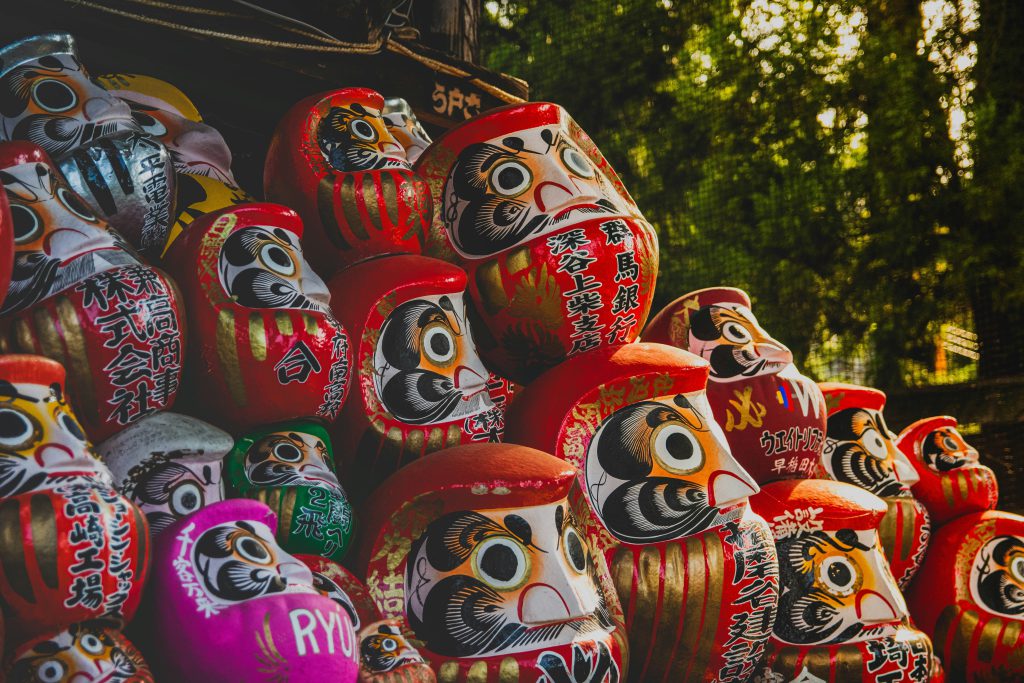
Gunma is located in the northwest of the Kanto region, about two hours from Tokyo. A large portion of the prefecture is mountainous and the remaining—including most of Gunma’s largest cities—are in the plains. Three major mountains—Mt. Akagi, Mt. Haruna, and Mt. Myogi—dominate Gunma’s landscape.
Although often thought of as an inaka (countryside) prefecture, Gunma has a mix of both city and outdoor attractions. In Gunma’s city areas, you’ll find several museums, malls, shopping centers, sports centers, clubs, bars, restaurants, and more to provide entertainment in a more suburban lifestyle.
Outside the city, Gunma has many more attractions—mountain climbing, hiking, skiing, rafting, “canyoning”, biking, onsen (hot-spring baths), museums, and much more. Gunma is famous for its winding mountain roads, and motor enthusiasts can find plenty of places to enjoy themselves.
For those interested in culture, you’ll not find it lacking in Gunma—the summer is filled with festivals. There are also plenty of temples, shrines and other religious sites, and many places in Gunma offer demonstrations, examples, and instruction in traditional arts, crafts, cooking and much more.
Ready to learn more about each region? Choose one below!

Seimō
Major centers: Annaka, Fujioka, Kanna, Kanra, Nanmoku, Shimonita, Takasaki, Tomioka, Ueno
Seimō as a region includes Gunma’s largest city, as well as one of its smallest villages. It offers everything from modern comforts to quiet, breathtaking nature. While Takasaki is Gunma’s largest city outside of the city center you will find natural wonders beyond your wildest imagination.
Seimō boasts two of Gunma’s three famous mountains: Mt. Haruna and Mt. Myogi. Seimō’s local festivals are famous throughout Gunma and attract people from all over Japan. During the summer, Yoshii-machi has its nationally famous “Mud Festival.” Also, Nanmoku hosts its annual “Fire Festival,” featuring incredible fire acrobatics. Kanra is famous for its annual “Samurai Festival” in which you can march in full samurai costume underneath the blooming cherry blossoms.
Chumō
Major centers: Maebashi, Isesaki, Shibukawa, Yoshioka, Shinto, Fujimi, Tamamura
The Chūmo region is located right in the center of Gunma and has a great atmospheric mix of city and suburban living.
Maebashi has the largest population in the Chumō region, is the capital city of Gunma, and has a great suburban feel. Maebashi also has Keyaki Walk, an indoor shopping mall featuring a variety of excellent restaurants, shops, and a Kinokuniya bookstore.
Isesaki is the second largest city in the Chumō region, and is one of the fastest growing cities in Gunma. It has a sizable Brazillian and Peruvian population, which means there are some great restaurants in the area. Isesaki is also home to Kezoji Park, a great place to have hanami or ride the ferris wheel.
Shibukawa has the third largest population out of the cities in the Chumō region, has a very active international society, an amusement park, and is known as the geographical center of Japan, making it a unique place to visit.
Tōmō
Major centers: Kiryu, Midori, Ota, Oura, Oizumi, Chiyoda, Tatebayashi, Meiwa, Itakura
The Tōmō region is located in south eastern Gunma and borders Saitama, Tochigi and Ibaraki. It offers a more countryside view of Gunma and there are plenty of things to see and do in this area.
In early August, Kiryu’s Yagibushi Festival is a must see. The city’s main street is packed with people of all ages dancing, eating, and drinking. You can also visit Gunma Insect World in Kiryu.
Ota and Oizumi are known for their Brazilian populations and Oizumi is also host to a Brazilian-style festival in the summer. If you need to go shopping and Tokyo seems too far away, Ota’s Aeon Mall is easily accessible by bus from the train station.
For nature lovers, Tatebayashi boasts one of Gunma’s best cherry blossom viewing sites in the spring in addition to being famous for its azaleas and irises. If you enjoy art, Tatebayashi is also home to the Gunma Museum of Art and the Tomihiro Art Museum in Midori displays the work of quadriplegic artist, Tomihiro Hoshino.
Hokumō – Tone
Major centers: Numata, Minakami, Kawaba, Katashina, Showa
Tone is the northern-most region of Gunma. Many of the higher altitude areas can have cooler summers than other parts of Gunma, and cold but beautiful snowy winters.
Given its mountainous location, most of the region is relatively rural. Tone is blessed with an abundance of natural attractions such as amazing natural onsen, ski resorts for all skill levels, Oze National Park and hiking trails, making it a prime outdoor recreation destination all year round. Be sure to try some of the outdoor sports up in Minakami, such as bungee jumping, canyoning, rafting, and paragliding!
Tone is easily accessible via train and car; give the scenic route a go if you plan on driving! The stretch of Route 17 in Tone runs alongside the Tone River and many of the mountain roads provide breathtaking scenery.
Hokumō – Agatsuma
Major centers: Higashi-Agatsuma, Nakanojo, Kuni, Kusatsu, Naganohara, Tsumagoi, Takayama
Located in the west of Gunma, Agatsuma provides beautiful scenery year-round. Enjoy hiking during mild weather, and skiing and snowboarding in the winter.
The most well-known center in Agatsuma is Kusatsu Onsen, world famous for its natural hot spring. Kusatsu is also the home of Mount Shirane, a volcano containing a crater lake whose water has the highest pH level in the world!
Takayama is the home of the Gunma Astronomical Observatory and Lockheart Castle (an actual Scottish castle that was disassembled, shipped to Japan, and reassembled).
You can also visit Agatsuma Gorge, a hidden gem famous for its fall foliage.
Weather
Because of Gunma’s diverse geography, weather throughout the prefecture can vary. Winters, particularly in the mountains, can be cold, and higher elevations often experience lots of snow during the winter months. Gunma winters are famous for the karakkaze—dry, cold winter winds of impressive intensity.
During the summer, Gunma—like all of Japan—is hot and humid, and particularly in the cities reach the upper 30s. During the summer, sudden thunderstorms or rain showers are common, particularly during tsuyu, the rainy season, beginning in June. For those who haven’t experienced all four seasons, you’ll experience them in Gunma, both in their beauty and in their frustration.
You can read more about what to do and how to cope in the various seasons in our Seasonal Guides.
Getting Around
Gunma has several public transportation options available. However not all areas are serviced and the majority of Gunma’s residents rely on private vehicles. Public services may only run two or three times an hour in urban areas, and once every hour, or even less frequently, in rural areas. For more information on the various public transport options available, please check out the transport guide.
Further Afield
In neighboring areas, residents of Gunma can find popular tourist areas, such as Nikko and Nagano, and Gunma is close enough to Tokyo that the city can easily be done in a day or even all weekend.
